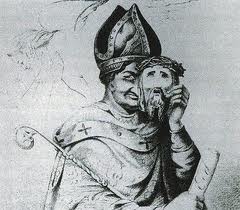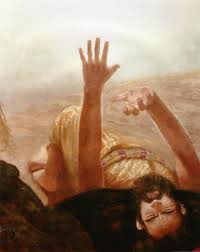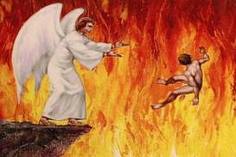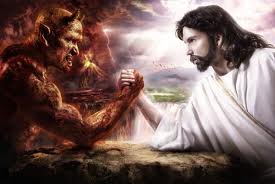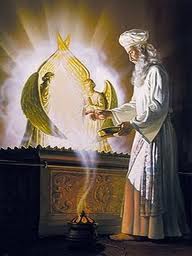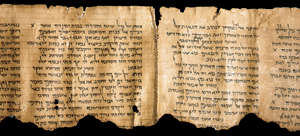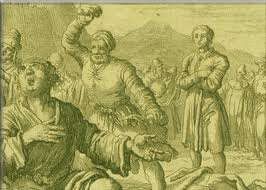|
WARNING! |
|
|
|
DELUSIONS AHEAD! |
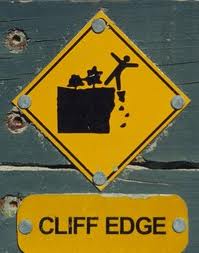
|
What Saint Paul told us ABOUT DELusions While we were sleeping! |
|
Below is one artist's depiction of the experience of Saul of Tarsus near the Middle Eastern city of Damascus as he told of it in the Bible as recorded in Acts 9:1-12. We Christians, because we are a gullible bunch, and rather imaginative also, have assumed that Saul of Tarsus came riding into Damascus with a squad of soldiers intent on hunting down every believer that Christ was the long looked for Messiah with a warrant from the Jewish High priest in Jerusalem to carry them off to jail. And then, Shhhs-BAM, he fell off his horse as a blinding light from heaven rendered him completely helpless. And he saw a twelve-foot-high apparition of Jesus Christ, the pope-above-all-popes demanding to know how come Saul was persecuting him. Here's Saul, lying on his back in the dirt, mumbling and whining like a sick puppy, wanting to know how he can get his eyesight back. We see all this because that's what an Essene author named Luke wanted us to see. And that's what we want to see also, because a little later Saul, renamed Paul, will offer us everything for nothing. Eternal life instead of burning in hell forever.
It's a simple transaction Paul asks us all to make, anyone can do it in ten minutes or less, and if you are fortunate enough to be born in a Roman Catholic family, somebody is sure to have done it for you as a newborn child as soon as you could be taken to church without catching pneumonia. A few words in Latin, a dab of holy water on your head, and the devil can never have you, even if you grow up to be a Mafia boss or his mistress. The Real story of that Incident at Damascus
Left:Barbara Thiering's book on "Pesher" Right: Essene high priests wore white garments The real story of the incident at Damascus shows it has been altered by Luke and Paul to, in effect, DELUDE us Gentile readers of the story, although it was understood accurately by those Essenes who understood "Gospel Pesher" when the story was published in the Book of Acts. I'm assuming that this book was available piecemeal long before it was finished and was circulated like a news letter, as were Paul's epistles to the various small companies of believers in his new doctrines in the various cities where he visited. Luke uses the same type of distorted meanings ("Gospel Pesher") in Acts as he does in the Gospel of Luke, making Acts an ongoing addition to his gospel. I believe most people who read the Bible understand at least that part of what I am saying. What they don't understand is that both Luke and Saul of Tarsus were Essenes, as was also Jesus Christ, and that Jesus was still alive when this incident happened. The major distortion we are made to believe is that Jesus appeared to Saul as a "vision" or "apparition" when indeed he saw Jesus alive and in person at this time. Now for the rest of the story. Dr. Barbara Thiering PhD, who has made a study of how the Essene authors of these stories hid the truth of what was happening in ways that now can be "decoded" using a process known as "Gospel Pesher", writes about this particular encounter of Saul's on page 139 of her book "Jesus and the Riddle of the Dead Sea Scrolls." "In march, while discussions preparing the council were being held, Saul attended the noon service in the vestry room of the Demascus buildings. It was the time when the villagers and proselytes of the "Way", who had come on pilgrimage there, sat in the congregation while their priest said prayers up on the half-roof." "Jesus was permitted by the Magians to act as a Second (alternate priest), and on some occasions stood in for the priest. He would be on duty at this service. Saul, as he had written in the Commentary on Habbakkuk (one of the famous Dead Sea Scrolls), had the strongest objection to him: he was neither a legitimate David nor a legitimate priest." "Saul took his place in the congregation. The noon hour came, and, as was the custom, part of the roof was removed, allowing the sun to shine down to indicate the time (no clocks in those long-ago times), and to reveal the priest in his prayers above. Saul prostrated himself with the rest of the congregation, averting his eyes to avoid looking too long up into the sun. The Voice, that of Jesus, spoke to him." Acts 9:4 "And he fell to the earth, and heard a voice saying unto him, 'Saul, Saul, why persecutest thou me? 5 And he said, Who art thou, Lord? And he said I am Jesus whom thou persecutest: it is hard for thee to kick against the pricks." Continues Thiering: "Jesus know of Saul's hostility, and spoke directly to him. "You are persecuting me". Saul replied: "You are illegitimate". Jesus answered with the "I am", affirming that he was a full priest. He then invited Saul into the forward part of the congregation, where he could hear the sermon. As he listened to Jesus, his strenuous objections to all that Jesus stood for began to dissolve. He recognized his own state of bondage to the Law, and the way in which it was binding others (referring back to the "bound" phrase of verse 2)." Acts 9:6 And he trembling and astonished said, Lord, what wilt thou have me to do? And the Lord said unto him, Arise, and go into the city, and it shall be told thee what thou must do." [Now Luke's "garden path" which makes of this a "magical story" -- which people debate to this very day!] 7 And the men which journeyed with him stood speechless, hearing a voice, but seeing no man. 8 And Saul arose from the earth; and when his eyes were opened, he saw no man; but they led him by the hand, and brought him into Damascus. 9 And he was three days without sight, and neither did eat nor drink." Thiering explains: "During the days that followed Saul received instructions in the eastern part of the monastery building, the "house of Judas". Ananias-Simon took part in the instruction, as Saul began to transfer his loyalty from the Hebrews to the Hellenists. But he was soon to make a distinction between the peace and war Hellenists, rejecting the latter. It was probably Simon who gave him the lesson about the resurrection which he later used as a part of the accepted teaching for the less advanced members. "Saul had begun his instruction in a state of "blindness", that is as a novice. But when he received full initiation into the party he "saw the light of life", an expression that is found in the [Dead Sea] scrolls." "Between AD 40 and 43 he was given the revised form of education, at the end becoming a bishop. The following year his name was changed to Paul, and he was appointed to the mission to uncircumcised Gentiles in the west." Habakkuk I think it's fair to say that most Bible readers other than scholars don't read much in the small book of Habbakkuk, one of the minor prophets located just after Nahum in your King James Bible. However, Dead Sea Scroll scholars became interested in it because one of the first major scrolls discovered in Cave 1 near Qumran was the "Habbakkuk Pesher" or "Commentary on Habbakkuk". By studying this scroll much was learned about the people who wrote the Dead Sea Scrolls, what they believed, and how they interpreted Scripture. In Jamiason, Fausset, & Brown's Commentary on the Whole Bible pages 827 to 833 are devoted to Habakkuk. "The time seems to be about 610 BC. For the Chaldeans attacked Jerusalem in the ninth month of the fifth year of Jehoiakim, 605 BC --And Habakkuk (ch.1:4,5 etc) speaks of the Chaldeans as about to invade Judah, but not as actually done so. In chapter 2 he proceeds to comfort his people by foretelling the humiliation of their conquerors, and that the vision will soon have its fulfillment." The "Habakkuk Pesher"
Geza Vermes in his much-acclaimed book The Dead Sea Scrolls in English, Third Edition, 1987, page 283, has this to say about the scroll labelled I QpHab (which indicates the Habakkuk "Pesher" found in Cave 1 of the Dead Sea Scrolls). "This well-preserved and detailed exposition of the first two chapters of the book of Habakkuk comes from cave 1 and was published in 1950 (m. Burrows, The DSS of St. Mark's Monastery pls. LV-LX!). The copy dates probably to the late first century BC. The Habakuk Commentary is one of the main sources for vthe study of Qumran origins as well as the Essene Bible exegesis and the sect's theology regarding prophecy." Here are a few quotations from Verme's book that we will be dealing with in our next section. "So the law is weak [and justice never goes forth] (1, 4a-b) [Interpreted] this concerns those who have despised the Law of God .... [for the wicked encompasses] the righteous (1, 4c) [The wicked is the Wicked Priest, and the righteous] is the Teacher of Righteousness ... O traitors, why do you stare and stay silent when the wicked swallows up one more righteous than he? (1, 13b) Interpreted, this concerns the House of Absolom and the members of its council who were silent at the time of the chastisement of the Teacher of Righteousness and gave him no help against the Liar who flouted the Law in the midst of their whole [congregation]. [But the righteous shall live by his faith] (ii, 4b) VIII Interpreted, this concerns all those who observe the Law in the House of Judah, whom God will deliver from the House of Judgment because of their suffering and because of their faith in the Teacher of Righteousness. Moreover, the arrogant man seizes wealth without halting. He widens his gulletlike Hell and like Death he has never enough. All the nations are gathered to him and all the peoples are assembled to him. Will they not all of them taunt him and jeer at him saying, 'Woe to him that amasses that which is not his! How long will he load himself up with pledges?' (ii, 5-6) Interpreted, this concerns the Wicked Priest who was called by the name of truth when he first arose. But when he ruled over Israel his heart became proud, and he forsook God and betrayed the precepts for the sake of riches. He robbed and amassed the riches of the men of violence who rebelled against God, and he took the wealth of the peoples, heaping sinful iniquity upon himself. And he lived in the ways of abominations amidst every unclean defilement." etc. etc. Once the Dead Sea Scroll scholars had interpreted this entire "Pesher" they needed to distance this scroll from the obvious cases of John the Baptist (who was beheaded) and Jesus (who was crucified) so they dated this scroll and many others to before the first century AD on the basis of the shape of the Hebrew letters (erroneously according to some scholars, including Robert Eisenman and Dr. Barbara Thiering, PhD) Both these scholars connect Saul of Tarsus with the Habbakkuk Pesher. In 37 AD, not in late BC. In both cases in which Saul of Tarsus first encountered Jesus early in the Book of Acts, Jesus Christ was acting as an Essene High Priest. In Saul's opinion, and in the opinion of Saul's fellow Essene students at Qumran, Jesus had no proper genealogical background to act as a High Priest, nor even for that matter to act as an Essene Messiah, being the extra-marital son of Joseph, conceived before Joseph was married to the "Virgin" Mary. Thus, to Saul, Jesus could be compared to the "Wicked Priest" of Habakkuk.
Saul of Tarsus and the "Habbakkuk Pesher" Barbara Thiering PhD begins Paul's story in her book "Jesus and the Riddle of the Dead Sea Scrolls" not with the incident at Damascus, which happened on February 29, 40 AD, but with his birth in 17 AD. Thiering understands Essene calendars and Pesher to such an extent she can figure out from later events when some of these Essenes were born. Most of chapter 30, "Saul the Indignant Student" gives the early life story of the man who almost single-handedly "invented" the religion we now call "Christianity".
Page 136 "In late AD 37, a young member of the (Essene) order of Benjamin, by the name of Saul, was spending part of his prenovitiate year at Qumran. Born in September, AD 17, he was just twenty years old. Having watched the laicisation (symbolic stoning) of Jonathan Annas (under the name of Stephen) while he held the priest's vestments, he retained a life-long dislike for him." "Saul, with the other students, watched the march of the army of the Roman governor Vitellius only a short distance from Qumran. During September Vitellius brought two legions of heavily armed infantry and cavalry down towards the Dead Sea, intending to cross to Petra to attck Aretas the Arab, who had been an enemy of the Herods since the tetrarch had divorced his daughter to marry Herodias. Vitellius came dangerously close to the remaining Qumran treasures, and it was known that he knew of their existence. Leading Jews went to meet him and implored him not to march through their land, for, they said, it was against their tradition to allow the military standards carrying images to come on holy soil. Vitellius gave in and changed his route, then made a point of showing respect for Jewish worship by attending a festival in Jerusalem." "But it was not before Saul had taken part in the composition of a pesher on the prophet Habakkuk, a work that survived and has come to us in the Dead Sea Scrolls. Having been instructed in the Baptist's technique of interpreting scripture, he turned to Habakkuk, applying to it the principle of turning universals into particulars. He found in it exact statements of historical fact, predictions of all the stirring events of recent years which were the subject of conversation at Qumran. It was easy to relate the Chaldeans, who "march across the breadth of the earth to take possession of dwellings which are not their own", and who were "fearsome and terrible", to the Romans, or Kittim, or, more precisely, the armies of Vitellius who were so frighteningly close. The prophet even referred to their military standards, in a disguised form, and gave rise to the comment that the Romans "sacrifice to their standards and worship their weapons of war". "When the prophet referred to a certain "arrogant man", uttering four Woes (curses) against him, it was clearly, in Saul's mind, a prediction of the man who was teaching such heresies that he was threatening the very existence of Judaism. Jesus, the "Man of a Lie" (the bastard) and the Wicked Priest, the Anti-Priest, had "flouted the law in the midst of the whole congregation", declaring himself to be a priest in the place of the descendent of Levi. He was a hater of eastern celibates, called the Poor, and had broken the purity rules. This meant he had "defiled the temple". He had suffered grievously, as anyone who was at the centre a few years before could attest. His opponents had inflicted "horrors of evil sickness and taken vengeance upon his body of flesh". His treatment was considered to be well-deserved, because he had attacked the Teacher of Righteousness, the Baptist. Through divine intention he had been "humbled by means of a destroying scourge, in bitterness of soul, because he had done wickedly to his elect"." "Saul's involvement can be seen in two passages in the document, in which he treated verses in Habakkuk in precisely the same idiosyncratic way as he, in his later role as Paul, treated them in his epistles. In one, he changed the meaning of "the righteous shall survive by his moral steadfastness" to "the just shall live by faith [in the redeeming figure]" --- in the early document, faith in the Teacher, in his later epistle to the Romans, faith in Jesus. The other Habakkuk passage spoke of people who would not believe an event because it was extraordinary. Saul changed its meaning to "a wilful refusal to believe what ought to be believed"; the Teacher's doctrine in the early document, and the Christian doctrine in the speech in Acts 13." "For the three years of his further education, in Jerusalem and in Damascus, Saul continued to attack the Christian heretics and especially their leader Jesus. He was convinced that they posed a real threat to the great work of spreading the Jewish faith among Gentiles. Allied with the Boethus family of priests, he worked for their return to the high priesthood, and looked to James in Damascus as the one who would occupy the throne of David when the kingdom came." "Combined councils had been held in Damascus. In March, AD 40, Ananias (Simon Magus) came there with Jesus from the Caesarea community. One reason for the meeting was the date. For the original Herodian (prophecy) scheme beginning in 41 BC, this was the end of eighty years and should have seen the end of the holy war and the conquest of the world. It had plainly not happened, and this was a serious disappointment to the order of Benjamin, whose leader Hillel had been involved in the original sceme." "Whenever a prophecy was not fulfilled, there were recriminations. The victory, it was argued, had not been sent from heaven because of errors in doctrine. A reforming process began, conducted through the debates of the councils. The ardent young Saul, who was now in his last years of studies under Gamaliel in Jerusalem, came to the council determined to prove that the stumbling block had been the easy doctrine of the western mission toward Gentiles." "But there was another point of view, that the impediment was Saul himself. Palistinian practices of circumcision were alienating Gentiles who would otherwise embrace the spiritual aspects of the religion. Jesus had always taught that Gentiles could be admitted without adopting Jewish identity." It was at this point that the INCIDENT AT DAMASCUS happened. The direct personal confrontation between Jesus and Saul of Tarsus that resulted in his radical turn-around in beliefs and preaching that we call his CONVERSION. And Saul the "persecuter of Christians" became this religion's MAJOR THEOLOGIAN.
Paul Himself was Not Deluded by the "New Theology" he taught! Jesus Christ in his confrontation with Saul of Tarsus at the Essene center at Damascus convinced him that strict adherence to all the most minute Essene regulations was neither realistically possible for Gentiles, nor that preaching this was necessary would make the world better. Love was the important thing, not regulations. Paul, in his later letter to the Corinthians, wrote the chapter on Agape Love that became a world classic (1 Corinthians 13). But Paul himself never forsook the Essene regulations that he learned as a youth, and advised the Galatians in Galatians 6:7:
Although Saul, as the Apostle Paul, later taught that Jesus had lived a "perfect life", a far cry from the multitude of criticisms he had earlier had of Jesus' 3 1/2 years as an Essene Messiah, Paul was using "Perfect" here in a comparative, not a superlative, sense. Compared to his target audience of Gentile listeners and readers (including us) Jesus, as an Essene, had indeed lived a "Perfect Life". Any major infringement of the Essenee rules would have resulted in Jesus' expulsion from the Essenes, and since Jesus had, in fact, been never expelled from the Essenes, he was, like Paul himself, a "Perfect Man". Paul, however, like the rest of the Essenes, used "Gospel Pesher" to say things in such a way that we can be expected to misinterpret them in the manner and to the degree that they intended for us to do. Thus misinterpreted they become to us a Delusion. Or to put it more plainly, A LIE. Paul in his earlier student years saw Jesus as "The man of a LIE." Later, after his conversion he was willing to teach this "Man of a LIE" to us without undue embarrassment on his part. He could, for instance, stand on a platform with the living Jesus, who had, as Paul fully understood survived crucifixion, and still bore the marks of this crucifixion on his person, and still, with Luke's collusion let us think that Jesus was a divine being in heaven at the time this public appearance of Jesus was going on. Paul knew that all we would have 1900 years later was Luke's account, and that part of this account was indeed a Delusion. The Divine Trinity The Ultimate Christian Delusion Although Paul himself never preached that Jesus was part of a Divine Trinity he knew that such a doctrine would be invented and taught after his death, and probably knew also that his own gospel would be used as a springboard to convince the Western World of this Ultimate Lie. I can say this with confidence because Paul's prophecy recorded in one of his epistles to the Thessalonians was about this DELUSION. The DELUSION of the Trinity. Paul knew about the Egyptian Trinity. And that some of the students at Qumran belonged to the Egyptian Therapeautae, who paid even more heed to these old Egyptian ideas and theories. The author of the Gospel of John promotes that Jesus could be considered to be a part of this Egyptian Trinity, and Paul knew the author of the Gospel of John, which was John Mark. Paul and John Mark traveled together at one time, and no doubt discussed what John Mark had written. "Only-begotten Son (of God)" (John 3:16) referred only to Horus in ancient theology and both John Mark and Paul knew that. And Horus was a part of the Egyptian Trinity of Osiris, Isis, and Horus. 2 Thessalonians chapter 2 is a prophecy about the Trinity, although most do not see it as such. Protestants, however, used to see it as a prophecy about the popes and the Papacy, which is pretty close to the truth. 2 Thess 2:1 "Now I beseech you brethren, by the coming of our Lord Jesus Christ, and our gathering together unto him. 2 That ye be not soon shaken in mind, or be troubled, neither by spirit, nor by word, nor by letter from us, as that the day of Christ is at hand." 3 Let no man deceive you by any means: for that day shall not come (what day? the day that Jesus returns as "god", as part of a divine Trinity) except there come a falling way first, and that man of sin (ordinary human, capable of sin) be revealed, the son of perdition (as contrasted to "son of God"). 4 "Who opposeth and exhalteth himself above all that is called God, or that is worshipped; so that he as God sitteth in the temple of God , showing himself that he is God."
5 "Remember ye not, that, when I was yet with you, I told you these things?" (Paul is obviously here referring to a lot of other things he told his congregations in Thessalonika that he does not here wish to put in print and circulate.) 6 And now ye know what witholdeth that he may be revealed in his time." 7 For the mystery of iniquity doth already work: only he that letteth will let, until he be taken out of the way."
8 "And then shall That Wicked be revealed, whom the Lord shall consume with the spirit of his mouth, and shall consume with the brightness of his coming: 9 Even him, whose coming is after the working of Satan with all the power and signs and lying wonders. 10 And with all the deceivableness of unrighteousness in them that perish; because they received not the love of the truth, that they might be saved."
11 And for this cause God shall send them a strong DELUSION, that they might believe a LIE: 12 That they all might be damned who believed not the truth, but had pleasure in unrighteousness." The rest of the chapter is the "Garden Path", the "cover up" in which Paul soothes his hearers back into their state of complacency and confidence to sleep on for another thousand years certain that they have believed the absolute truth as being taught by the Apostle Paul. How the "Divine Trinity" and the "Second Coming" are Related Although the Millerites (followers of the Baptist Evangelist William Miller) were Trinitarians (believers in a Divine Trinity) the group that later became the Seventh-day Adventists were not, initially at least, Trinitarians. What made the difference was logic and Bible study. Hiram Edson experienced what he sometimes called a "divine revelation" in which he saw in his mind a vision of Jesus standing in the Holy Place of a Jewish sanctuary about to enter the Most Holy Place as a High Priest on the Day of Atonement. This is how the Seventh-day Adventists eventually came to explain what had happened on October 22, 1844, when William Miller and the Millerites had expected Jesus to come in the sky and take all the Millerites (and perhaps a few others) to heaven before destroying the rest of the world's teeming millions by fire. A teenager of this group named Ellen Harmon started having regular visions and dreams in which she saw Jesus as a High Priest dressed in regular Jewish high priestly garments officiating in some type of heavenly sanctuary. Although not a scholar herself, Ellen Harmon's associates were some of them scholars and realized that in all the histories of earth's peoples and their gods, no one had ever been both a god and a high priest. High priests are intermediaries between their fellow humans and various gods, and this has been the case since the most ancient of times. One can be the son of a god and be that god's priest, provided this son has a human mother. But a person who is 100% god is entitled to have priests, and a high priest of his own, not be one. Ellen (Harmon) White in later visions saw Jesus as being human, and claimed that she never really saw God (the Father) in any of her visions. So for about 100 years, no Adventists were officially Trinitarians. The main reason Adventists are now Trinitarians is that they have succumbed to the overpowering DELUSION. It's not that they care whether Jesus is sitting there on a triple Divine Throne in heaven in complete equality in every way with the Father and the Holy Spirit (the Nicene Formula) but that they really desire the perks and benefits they imagine must come with a Divine Jesus. IF JESUS IS NOT FULLY DIVINE, then logically He has no Eternal Life to give us, not possessing it Himself to give us or others. IF JESUS IS NOT FULLY DIVINE, then He did not create this World, and has no power to create another world like this once we have totally trashed this one. IF JESUS IS NOT FULLY DIVINE, then someone else may be in charge of our World and ourselves after we die. Someone we don't know and have no way of knowing. SUMMARY: IF JESUS IS NOT FULL DIVINE, we must live with UNCERTAINTY. but if JESUS IS FULLY DIVINE, we have CERTAINTY. To most of us, religious UNCERTAINTY is intolerable. Paul had to deal with UNCERTAINTY. Sitting on a platform with Jesus, waiting for his turn to preach, he was fully aware that Jesus, the man next to him was a fellow human being. After the sermon they would go to the same bathroom and eat similar food. Paul could preach that Jesus rose from the dead, and could bring believers back from the dead also. But in all the years he preached that he never really saw it happen himself. And he assumed that when he himself, Paul died (lost his head, according to Roman tradition) that Jesus would not be there at his coffin uniting his head to his body, and saying, how did that sword feel, Paul? I'll bet it didn't hurt as long or as bad as hanging on a cross with iron spikes through your ankles and wrists! They had their joint secrets, Jesus and Paul. But being dead and coming back was not one of them. Since Jesus was never God in the sense the doctrine of the Trinity supposes, then he can never come back as God in the way that Christians since they invented the doctrine of the Trinity expect Him to. |
|
For more about Jesus as King of Kashmir: Click Here |
